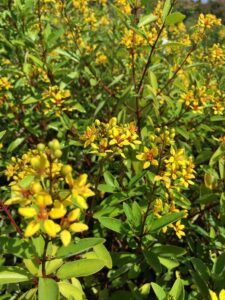S & J Nursery’s Guide to Growing
Thryallis Shrubs
( galphimia glauca)
For Northeast Florida, Jacksonville and St. Augustine area Landscapes
 Thryallis / galphimia glauca Origins:
Thryallis / galphimia glauca Origins:
– Originally a Central American( Mexico / Guatemala) plant, Thryallis has adapted well to Florida’s climates and makes an excellent flowering landscape shrub with little or no pest or disease problems making it a great low maintenance landscape selection.
Thryallis / galphimia glauca Preferred Exposure:
– Thryallis / galphimia glauca should be located in full sun to partially
shaded area of the North Florida | Jacksonville | St. Augustine landscape. If plants are located where it does not receive at least 6 hours of sun flowers will be less abundant than those planted in a sunnier location.
Thryallis / galphimia glauca Foliage:
-Small medium green foliage adds texture to the landscape.
– Evergreen foliage is cold hardy to 25 degrees but will regrow quickly if we
happen to get that much cold in our area!
Thryallis / galphimia glauca Soil Preference / Salt tolerance:
– Thryallis is tolerant of a wide range of soil conditions. .
– Thryallis has a low salt tolerance and should be avoided on coastal
properties.
Thryallis / galphimia glauca Size Variance:
– Thryallis shrubs will reach sizes of 4-9+ feet High and 4-6 feet wide. Annual pruning may be necessary to keep this shrub in its best form.
Thryallis / galphimia glauca Growth Habit:
– Thryallis shrubs have a naturally oval shape.
Thryallis Growth Rate:
– Moderate growing shrub quickly establishes itself into the landscape and here at S & J Nursery we see 6-8+ inches of growth each season.
Thryallis / galphimia glauca Bloom:
– Very underused landscape plant, perhaps a bit harder to find than most shrubs in the area. These plants are constantly blooming! Consistently covered in tiny yellow star shaped flowers. Very showy display.
– Perfect plant for lots of flowering display from very little care on
our part.
Thryallis Water Requirements:
– Thryallis / galphimia glauca is moderately drought tolerant once established into the landscape
but responds well to supplemental irrigation.
Best Uses For Thryallis / galphimia glauca:
– Thryallis is a great choice for a fast growing flowering shrub for sunny
areas of the North Florida | Jacksonville | St. Augustine area gardens and landscapes.
– Use them as the backdrop to the perennial border or as a foundation plant for homes or commercial plantings.
Care of S & J Nursery’s North Florida | Jacksonville | St. Augustine Shrubs:
– Shrubs can be planted in the North Florida | Jacksonville | St.Augustine area at any time during the year. In normal and well draining soils dig the hole as deep as the root ball and two to three times as wide. Plant the top of the root ball level or slightly higher than the surrounding soils. When
planting in poorly drained soils make sure to plant your shrubs a minimum of 3 inches ABOVE the surrounding soil level.
– Water every day during the establishment period. For most 3 gallon size shrubs in the North Florida landscape in average soil, that is neither heavy clay that holds water or really sandy that will take 2-3 weeks of daily watering to ensure that your newly planted shrub will begin to put out new roots and grow into its new home happily. After the first few weeks begin tapering back your watering to every other day then every third day and so on until your newly planted items are flourishing without your assistance.
– If planting larger shrubs you may need to extend the initial care a bit longer to protect your investment and get your shrubs off to the best start possible.
– IMPORTANT: If planting shrubs in heavy clay soils that hold allot of water after a rain or irrigating, remember to check the soil for moisture by sticking your fingers into the soil near the root ball of the newly planted shrub down to 2-3 inches. If it remains wet from the previous watering wait for the top 2-3 inches to dry out before watering again.
– IMPORTANT: When planting shrubs into poor sandy soils be sure to amend the planting hole by mixing compost or cow manure etc. with the native soil that will go back in the hole around the new plants root ball when installing your shrub material, this will not only give your new shrubs good soil to grow its new roots into but help it hold water.
– When planting shrubs from containers be sure to loosen the roots as much as possible pulling loose roots away from the root ball before installing your new plants, if the roots are to tight to easily loosen with your hands use a knife to cut a few slits into the root ball being careful to go all the way from the top to the bottom and making the cut at least an inch deep. This will ensure that your plant will immediately begin to form new roots into its new surrounding soil.
– Mulch newly planted shrubs whenever possible.
– Fertilize each spring with a mixture of Milorganite and a slow release poly coated plant food such as Osmocote or Stay Green general purpose plant food, sprinkling the fertilizer around the mulch circle underneath the foliage of the tree
– Prune as needed to shape each spring and or summer.

